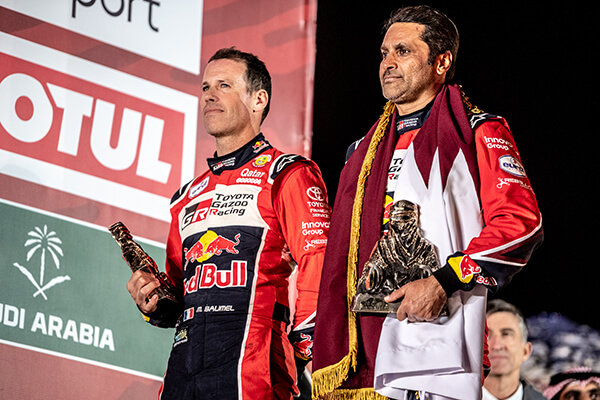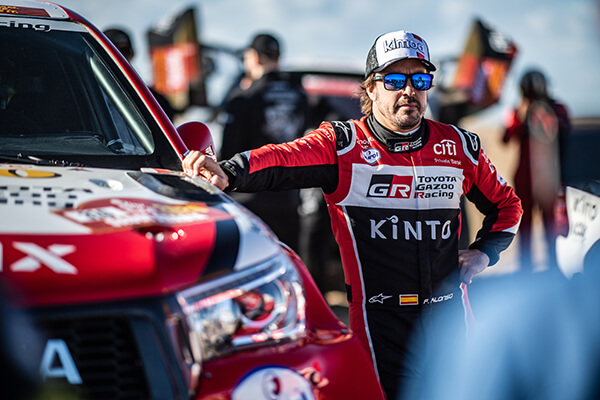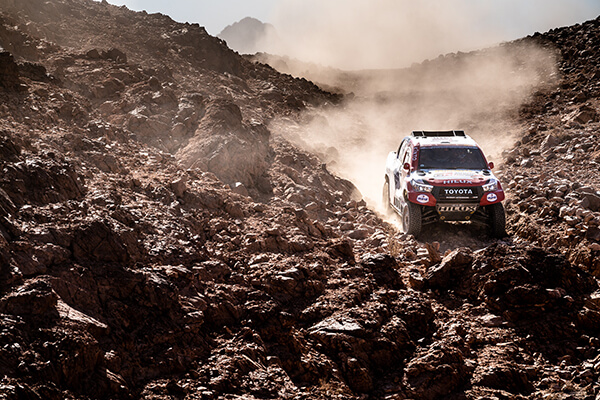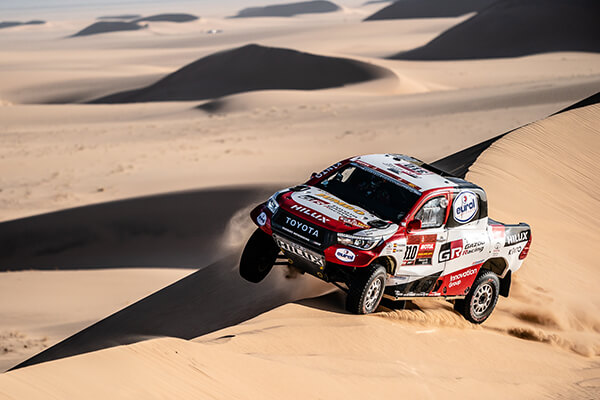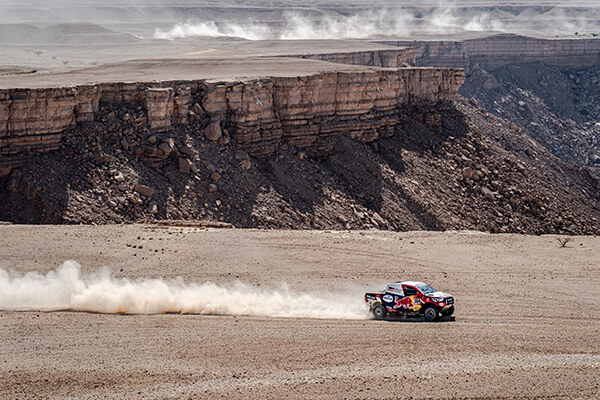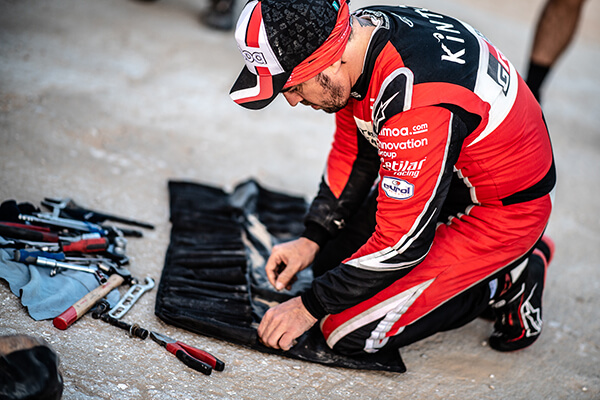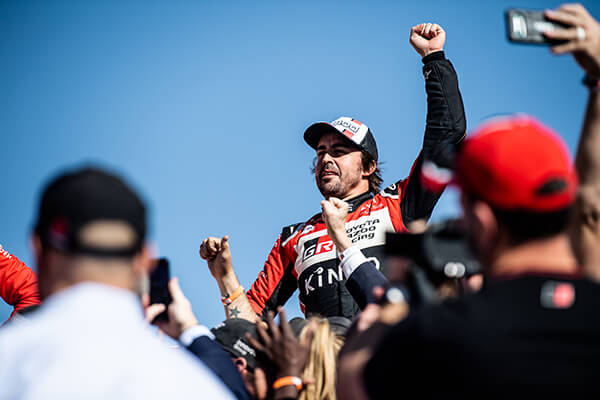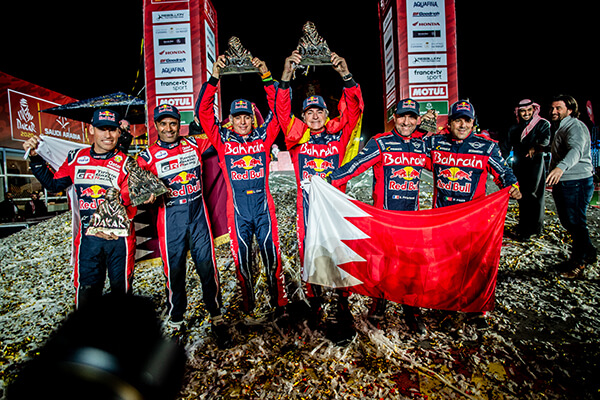REPORT
Report on the 2020 Dakar Rally - SUMMARY Report on the 2020 Dakar Rally
The 42nd edition of the Dakar Rally has come to a close. Having headed to the Middle East for the first time, the Dakar Rally was as tough as ever. Competitors faced seas of sand, dunes, and hidden rocks as they toured around Saudi Arabia. TOYOTA GAZOO Racing was on the podium with Qatari Nasser Al-Attiyah who came in 2nd. Giniel de Villiers came 5th, Bernhard Ten Brinke 7th, and Dakar rookie Fernando Alonso came in an incredible 13th place.
Racing across about 7,900km of Saudi Arabian sands, the 2020 Dakar Rally was one for the history books. Competitors looking for a respite from the Peruvian sands of the 2019 Dakar Rally will have to wait for another year, as 75% of this year’s race took place on sand. Along with this, new roadbook rules meant that navigators only had minutes to prepare before they set off each day.
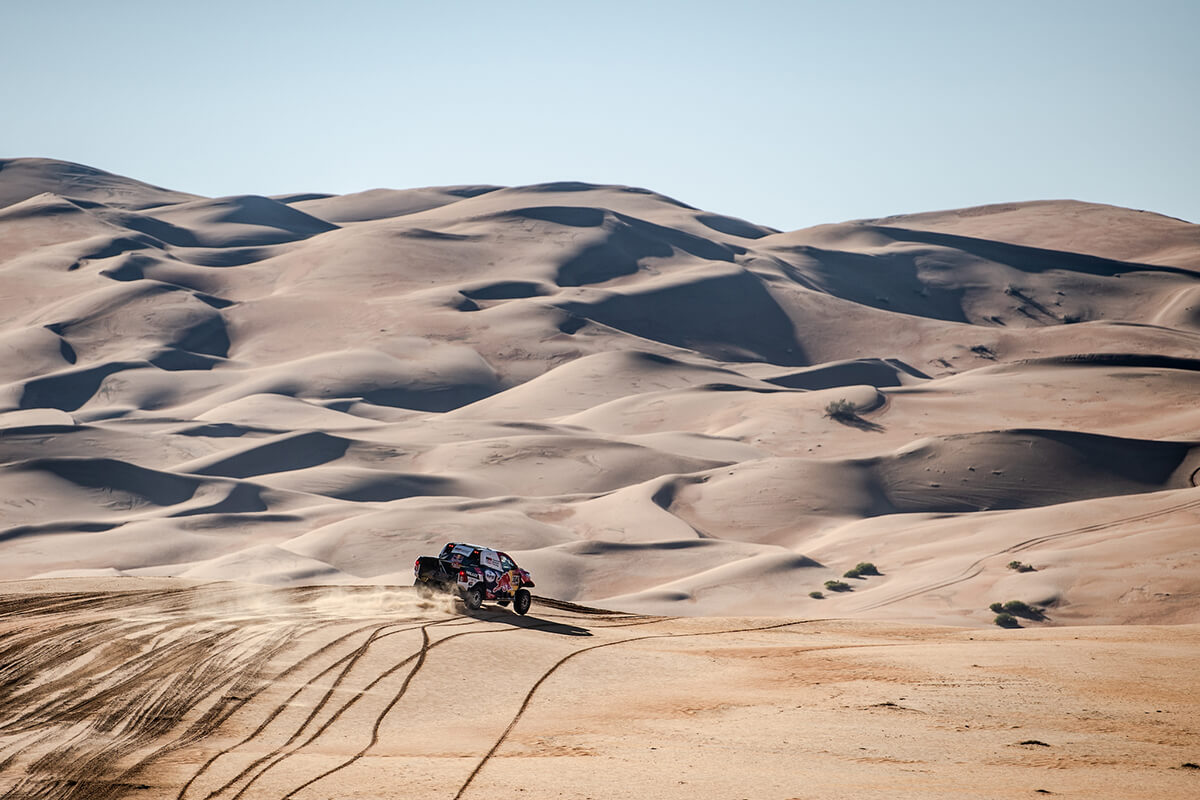
The rally raid began on January 5th, with 83 cars setting off from the historic city of Jeddah. While many competitors were ready for the sand, the rocky terrain may have taken some off guard, as all four TOYOTA GAZOO Racing (TGR) Hilux’s suffered tire punctures. Defending champions driver Nasser Al-Attiyah and navigator Matthieu Baumel in car #300 fought back from punctures and climbed to 4th place with driver Bernhard Ten Brinke and navigator Tom Colsoul in car #307 coming 5th. A driving legend but a rookie in the Dakar, Fernando Alonso finished his first-ever Dakar stage alongside navigator Marc Coma in car #310, coming in 11th, a very respectable finish for their first Dakar outing. Driver Giniel de Villiers and navigator Alex Haro Bravo in car #304 had it worst with four punctures in short succession. “It was a nervous end to the stage, as we had no spares left,” stated Giniel.
#304 immediately bounced back and managed a victory in Stage 2. Recording the fastest time of the day, de Villiers drove a perfect race down the Saudi coast to become the first person to win a Dakar stage on 3 different continents. Alonso in #310 had a quick lesson in what to expect from the Dakar: After posting competitive times in the early part of the stage, a large collision with a rock caused serious damage to his suspension and front left wheel. Spirits were not dampened, however, as TGR team principal Glyn Hall stated, “We’re confident that Fernando will still make it to the end of the race.”
Stage 3, a looped stage starting and ending in the futuristic megacity of Neom took competitors over more sand and rocks but also brought mountains into the equation. The stage required technical driving throughout, resulting in a more methodic, slightly slower race. The stage finished with all four TGR Hilux’s in the top 10. Alonso in #310 posted the fastest time for the team, coming in 4th on the day, a truly special achievement in his third ever Dakar Stage.
The competitors then raced away from Neom to the city of Al Ula in Stage 4, where they once again raced over a mix of sands and rocky roads. Pulling off second place, Al-Attiyah in #300 had a near-perfect run, “The Toyota Hilux ran absolutely perfectly, and they didn’t have a single puncture,” stated Glyn Hall. For the rest of the teams, punctures plagued the day with the teams all finishing with no spare tires left. Ten Brinke in #307 not only battled punctures but also the flu, a glimpse of what a nightmare the Dakar can be to some. However, 3 of the Hilux’s placed in the top 10, with Alonso narrowly missing out by coming in 13th.
Stage 5 was contested across sand and dunes, finishing with a Motocross style race with the top 3 competitors riding side by side against each other. #300 came in 2nd, and #304 came in 6th, even after driver de Villiers injured his neck. #310 drove a solid race, coming in 7th for the day while #307 lost time while searching for a waypoint.
The Rally was nearly half done as Stage 6 brought the competitors closer to the Saudi capital of Riyadh. Competitors had to be as comfortable as the camels around them as they flew over breathtaking desert scenery. All four TGR Hilux’s finished in the top 10, with #300 in 2nd place overall at the halfway point. #304 and #307 joined the couple in the top 10, placing 7th and 8th respectively. #310 was in 16th place, a very respectable position, especially after the damage setbacks they suffered in Stage 2.
Competitors then had a day of rest in Riyadh while their mechanics were hard at work, repairing and rebuilding their vehicles, to get them ready to take on the second half of the Dakar, especially Stage 7, the longest section of the race.
Competitors faced over 546km of racing between the Saudi capital and Wadi Al Dawasir in the south of the country. The stage contained technical terrain which favored the Hilux four-wheel drive abilities, however, it also had 250km of straight, full-throttle racing.
Stage 7 was struck by tragedy as motorcyclist, and Dakar legend Paulo Gonçalves passed away after suffering a severe crash. Toyota extends its sincere condolences to his family and friends.
At 477km, Stage 8 brought hours of racing for the competitors. As the stage was canceled for bikes and quad competitors, drivers had no tracks to follow and so were completely reliant on their navigators. Even so, Alonso performed admirably coming 2nd in the stage for the day, a remarkable achievement.
Weaving through the dunes of Stage 9, teams entered the Saudi Arabian “Empty Quarter,” which promised a few days of hard-packed roads and fast sandy tracks. Starting in 2nd, Alonso soon led the pack and opened the road. Alonso’s racing prowess has done him well so far, but the lack of Dakar experience began to show when navigation became tougher. Even with these difficulties, he still posted the 9th fastest time of the day. This result meant that after Stage 9, all four TGR Hilux’s had made it into the overall top 10.
Stage 10 and the feared marathon stage was upon the competitors. Marathon stage rules dictate that drivers cannot receive any help from their technicians and so any serious damage could spell the end of their 2020 Dakar Rally. That is why when Alonso rolled his vehicle twice over the side of a sharp dune, he would not have been mistaken for thinking that his Dakar experiment was over. However, luckily the main damage sustained was a broken windscreen, which they soon removed and drove without. The stage proved to be difficult for all the Hilux’s apart from De Villiers, who came in 3rd quickest of the day.
As stage 11 came, competitors faced the continued sands, dunes, and rocks. Al-Attiyah performed well and managed to come in 2nd, only 10 seconds slower than the race leader. The rest of the TGR Hilux’s also battled their way into the top 10 for another solid result.
The final stage took the competitors back to the Saudi capital of Riyadh and ended in the entertainment city of Qiddiyah. With Al-Attiyah in #300 earning a first-place finish over the short final stage, he has won at least one stage in every Dakar Rally since 2007. This finish cemented his overall 2nd place, putting him only 6 minutes behind the leader. “It was a tough fight […] but we’ll be back to fight again next year,” said Al-Attiyah at the end of the race. De Villers took 5th place; Ten Brinke in #307 came 7th; and Alonso in #310 came in 13th overall, a terrific achievement for the Dakar rookie, especially when combined with his top 5 stage finishes. In total, 61 cars finished the race, one of the highest finishing percentages in recent years.
Another Dakar Rally has come to an end, and the Toyota Hilux battled their way through the toughest race of all. All four TGR teams made it through punctures, rollovers, and about 7,900km of harsh terrain mostly unharmed, testimony of the quality, durability, and reliability of their vehicles. “In the end, we brought all four of our cars to the finish without any technical issues, that in itself is a great achievement, especially considering the terrain we had to traverse,” stated Glyn Hall as he reflected over the two weeks of racing.

